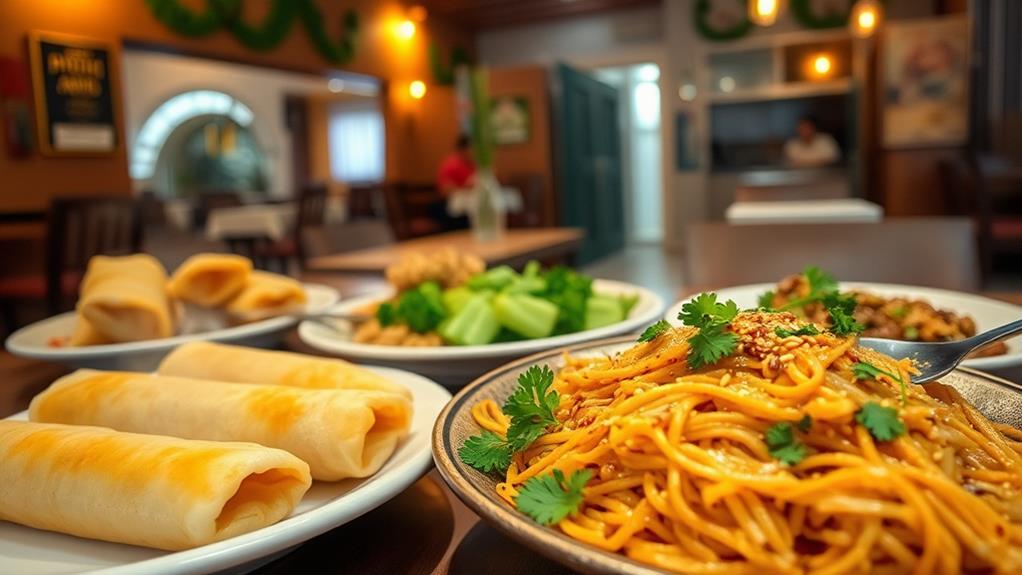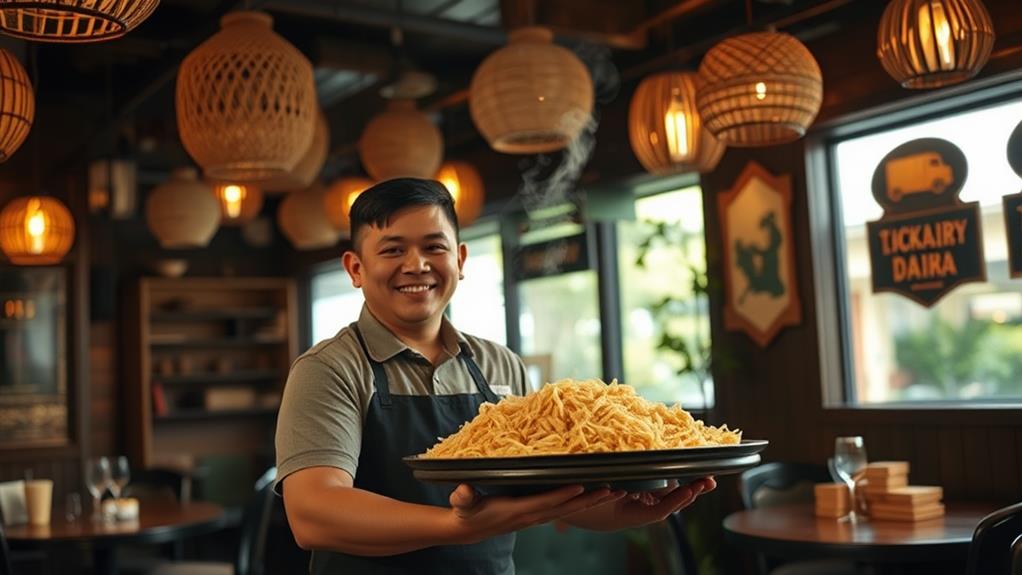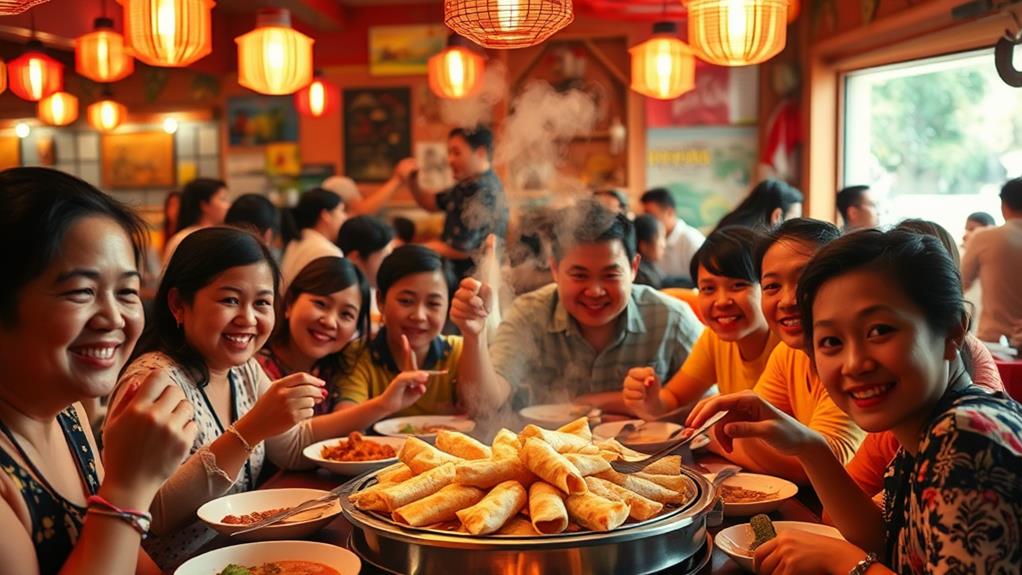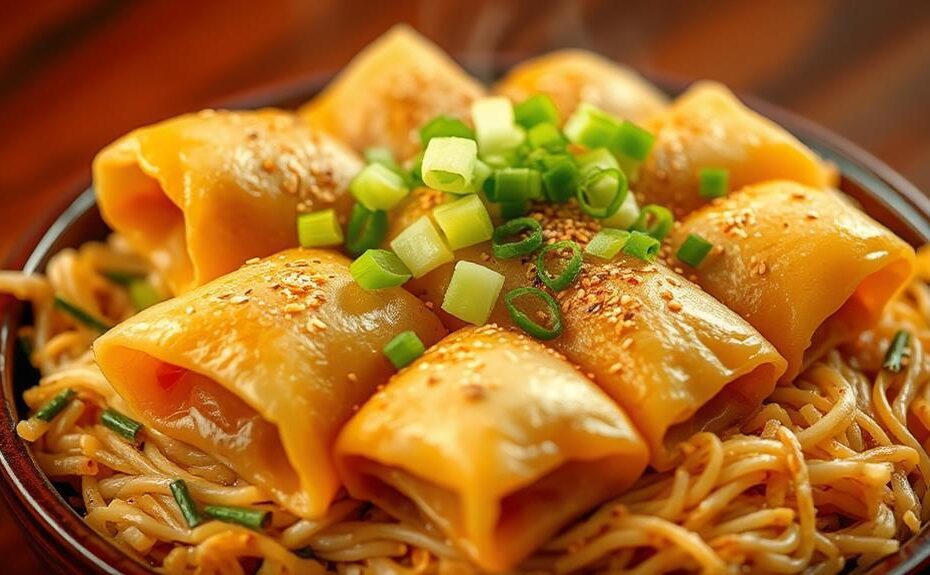Discover Authentic Filipino Cuisine
To experience the authentic taste of the Philippines, search for restaurants that serve traditional lumpia and pancit dishes. These eateries use fresh, high-quality ingredients and adhere to traditional cooking methods. This ensures crispy lumpia wrappers and flavorful pancit noodles, reminiscent of homemade cooking.
Traditional Cooking Methods
Restaurants that follow family recipes passed down through generations are more likely to serve authentic dishes. Look for eateries that cook their lumpia and pancit with love and care, just like a Filipino grandmother would. This attention to detail results in dishes that are rich in cultural heritage and flavor.
Cozy Atmosphere and Engaging Staff
The ambiance and staff can elevate the dining experience. Opt for restaurants with a cozy atmosphere and engaging staff who can share the story behind each dish. This will help you appreciate the cultural significance of lumpia and pancit.
Explore Hidden Gems
Venture beyond popular restaurants to find hidden gems that serve authentic Filipino cuisine. These eateries may offer a more genuine experience, allowing you to discover new flavors and appreciate the rich cultural heritage behind each dish.
Traditional Filipino Cuisine

Traditional Filipino cuisine is rich in iconic dishes that have been passed down through generations. Two of the most beloved and enduring staples are lumpia and pancit. These dishes aren't only delicious but also deeply rooted in the country's culture and traditions.
Lumpia, a type of spring roll, is typically filled with a mixture of meats and vegetables. It's often served with a side of garlic and vinegar dipping sauce to enhance its rich flavor.
The fillings can vary, but common ingredients include vegetables like cabbage and carrots, and meats like pork or beef.
Pancit is a flavorful noodle dish often served at celebrations. It's made by stir-frying noodles with various vegetables and proteins.
The noodles used are typically made from rice flour, and the vegetables and proteins can vary depending on the region and personal preferences.
What's great about pancit is that it's often made with leftover fillings from lumpia, adding flavor and resourcefulness to the preparation.
To try authentic lumpia and pancit, it's best to seek out restaurants that specialize in traditional Filipino cuisine. These restaurants often have recipes that have been passed down through generations, ensuring an authentic experience.
Be sure to ask about the ingredients and preparation methods to appreciate the cultural significance of these dishes.
Family Recipes and Cooking Techniques
Family Recipes and Cooking Techniques in Filipino Cuisine
Family Recipes:
In traditional Filipino cooking, family recipes are passed down through generations, with each family member contributing their own twist to the recipe.
A classic example is Grandma's lumpia recipe, which includes chicken, pork, cabbage, and carrots wrapped in spring roll wrappers for a lighter texture compared to egg roll wrappers.
Cooking Techniques:
The cooking process involves boiling chicken for 10-15 minutes and sautéeing pork with vegetables before assembling the lumpia.
To ensure the lumpia wrappers don't tear, a flour and water paste is used to seal them.
Ingredient Purposes:
Chicken adds protein and flavor when boiled for 10-15 minutes.
Pork adds texture and flavor when sautéd with vegetables.
The flour and water paste prevents the lumpia wrappers from tearing.
The garlic and vinegar dipping sauce enhances the flavor profile.
Authentic Atmosphere and Service

Authentic Atmosphere and Service
When you enter a top Filipino restaurant in Houston, such as Flip n Patties or Godos, you're immediately surrounded by an authentic atmosphere that reflects the warm hospitality and vibrant culture of the Philippines. This atmosphere is created by the sights, sounds, and aromas that transport you to the heart of the Philippines.
Friendly and attentive staff ensure a wonderful experience, making you feel like you're part of the family. They're always happy to help you navigate the menu, answer questions, and offer recommendations.
These restaurants are committed to community engagement, evident in their hosting of local events and cultural nights that foster connections among patrons and enhance the authentic atmosphere.
Traditional decor and music add to the cozy ambiance, making you feel like you're dining in a Filipino home. Regular promotions and events showcasing Filipino cuisine and culture further enrich the experience.
Quality Ingredients and Flavorful Dishes
Quality Ingredients and Flavorful Dishes
A top Filipino restaurant in Houston stands out by using quality ingredients and traditional cooking methods to create dishes that are bursting with flavor.
When it comes to authentic lumpia, fresh spring roll wrappers, chicken, pork, cabbage, and carrots are used to ensure a light and flavorful texture. The frying technique is crucial, with a recommended oil temperature to achieve that perfect golden brown crispiness.
For pancit, reserved chicken stock is used to cook the noodles, elevating the overall flavor profile of the dish. Dipping sauces made from garlic and vinegar provide a robust contrast to the savory flavors of lumpia.
These traditional pairings allow diners to experience the full range of Filipino flavors. By using quality ingredients and adhering to traditional cooking methods, these restaurants create rich flavors and textures that make lumpia and pancit beloved staples in Filipino cuisine.
Can I Use Lumpia and Pancit Ingredients for Authentic Filipino Lomi?
Yes, you can use lumpia and pancit ingredients for an authentic Filipino lomi recipe. The combination of these ingredients will give the lomi a unique and delicious flavor. It’s a great way to add variety to your lomi while still staying true to the authentic filipino lomi recipe ingredients.
Community Engagement and Cultural Heritage

Filipino restaurants in Houston engage with the local community beyond serving food. They participate in local food festivals to showcase authentic Filipino dishes and share traditional recipes. By collaborating with local businesses, these restaurants strengthen community ties and foster cultural appreciation.
For instance, they host cultural nights and cooking classes, where attendees can learn about the significance of lumpia and pancit in Filipino traditions.
These restaurants also support local charities and initiatives. They help preserve Filipino cultural heritage in diverse neighborhoods.
Through social media, they share stories and updates about their cultural events, enhancing community interaction and appreciation for Filipino cuisine.
In doing so, these restaurants contribute to the rich cultural fabric of Houston's communities, serving great food and promoting cultural heritage.
Frequently Asked Questions
Are There Variations of Lumpia and Pancit Across Different Filipino Regions?
Regional variations exist in Filipino cuisine, particularly in popular dishes like lumpia and pancit.
Lumpia, the Filipino spring roll, comes in different styles depending on the region.
In some regions, lumpia is sweet, while in others, it's savory or spicy.
Pancit, the staple noodle dish, also has various types, such as pancit habhab and pancit luglug.
The cooking methods used in different regions also differ, with some using soy sauce or patis, while others opt for vinegar or garlic.
Can I Request Customization of Dishes for Dietary Restrictions?
Restaurants often accommodate dietary needs. When dining out, inform your server about your dietary restrictions, such as gluten-free, vegan, or other requirements.
They will work with the chef to modify the dish to fit your needs. For example, if you're lactose intolerant, they can substitute dairy products with non-dairy alternatives.
Be open about your needs, and the restaurant will do their best to create a tailored meal that suits your taste buds and dietary requirements.
Are There Vegetarian or Vegan Options Available for Lumpia and Pancit?
Yes, vegetarian and vegan options are available for lumpia and pancit. Many restaurants now offer vegetarian alternatives to traditional lumpia and pancit.
For example, vegan lumpia can be made with plant-based protein sources like tofu or tempeh, wrapped in a crispy vegan wrapper.
Similarly, some places offer fully vegan pancit options, substituting meat with mushrooms or eggplant.
If you're unsure about the options, don't hesitate to ask your server, who'll guide you through the menu.
Do Restaurants Offer Cooking Classes or Workshops for Traditional Dishes?
Many restaurants offer cooking classes or workshops to teach traditional cooking techniques. These classes provide hands-on experiences that go beyond just teaching recipes. They delve into the cultural significance of each dish, exploring the history behind the recipe, the importance of specific ingredients, and the techniques passed down through generations.
By participating in these classes, you'll gain a deeper appreciation for the cuisine. For example, you might learn about the origins of a traditional dish like pad thai, how it was influenced by Chinese cuisine, and the significance of using specific ingredients like fish sauce and lime juice.
With this knowledge, you'll be able to recreate authentic dishes on your own.
Are There Any Unique or Rare Filipino Ingredients Worth Trying?
Filipino cuisine is known for its unique ingredients, which are essential to traditional dishes.
Patis (fish sauce) and suka (vinegar) are two fundamental spices that add depth to many recipes.
Exotic vegetables like bitter melon and okra are staples in many Filipino households. These vegetables are often used in dishes like sinigang, a sour soup, and pinakbet, a vegetable stir-fry.
Ube, a vibrant purple yam, is another unusual ingredient used in both sweet and savory dishes. It's commonly found in desserts like ube halaya, a purple yam jam, and is also used as a topping for shaved ice desserts.
